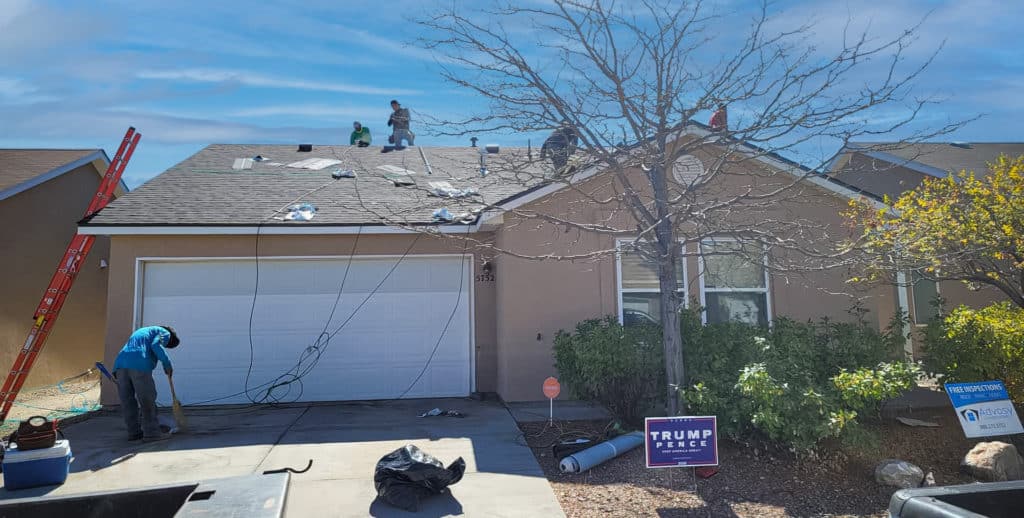Roof sheathing is an important part of structural roofing systems. It serves a variety of functions and provides stability for the roof structure. In Arizona, there are several options for roof sheathing material that can be used to protect roofs from weather elements like rain or wind. This article will discuss the different types of sheathing materials available in Arizona and what considerations should be taken into account when choosing one.
The decision between using either solid wood boards or engineered paneling ultimately comes down to personal preference, budget constraints, local building codes, and environmental conditions. Understanding the pros and cons associated with each type of sheathing material allows homeowners to make informed decisions about which product would best suit their needs in Arizona’s arid climate. The next section will explore these factors further so that readers can gain insight into which option might work better for them personally.
Definition Of Sheathing
Sheathing is a material used to cover the exterior of a structure. It serves as an additional layer between the interior walls and the outside elements, providing protection from weather conditions such as rain, snow, wind, and hail. Common materials used for sheathing include plywood boards, metal sheets, rigid foam insulation board, and oriented strand board (OSB).
The primary purpose of sheathing is to create an airtight barrier that prevents moisture infiltration into the building envelope. Additionally, it provides structural support to hold up other components of the roofing system such as shingles or tiles. Sheathing also acts as a brace against high winds and helps keep debris out of gutters and drains. Properly installed sheathing will increase energy efficiency in buildings by blocking airflow through gaps in siding and trim.
Benefits Of Sheathing
Sheathing is an essential part of any roof in Arizona, providing a layer between the house and the elements. The most common types are oriented strand board (OSB) sheathing and plywood sheathing. Both provide insulation for roofs in hot climates such as Arizona, prevent water intrusion and keep out pests, including rodents and insects.
In addition to protecting from the elements, OSB and plywood sheathing also can give roofs extra support when necessary due to their high strength-to-weight ratio. This makes them suitable for both flat or pitched roofs that require additional reinforcement. Additionally, they can act as sound insulators, blocking outdoor noise from entering your home while keeping indoor noise levels down if you live close to neighbors.
The installation process for both OSB and plywood sheathing is relatively simple compared to other materials used on roofs in Arizona. Once installed correctly, these two types of sheathing have proven to be durable under harsh climatic conditions with minimal upkeep required over time.
Common Building Materials Used In Arizona
Arizona has certain climate conditions that need to be taken into consideration when constructing a building. Several materials are used for roof sheathing in Arizona, the most common being plywood and oriented strand board (OSB). Plywood is made by gluing together layers of wood veneer with an adhesive. It is available in thicknesses ranging from 3/8 inch to 1-1/2 inches, making it suitable for both low slope and steep slope roofs. OSB consists of strands of wood compressed together with wax and adhesive to form sheets. It is also available in various thicknesses, usually 7/16 inch or 19/32 inch, allowing it to accommodate several types of roofs. Other options include hardboard siding which is composed of resin-impregnated fiber panels, as well as plastic sheathing panels such as vinyl siding or stucco synthetic lath products.
The choice of material should depend on factors such as local availability, cost effectiveness, durability against moisture damage and other environmental factors like hail storms or extreme temperatures. Different types of insulation will also have to be considered depending on the type of climate found in each region across Arizona.
Fire Safety Requirements For Roofs In Arizona
In Arizona, the most common type of roof sheathing is plywood. Plywood provides a strong and durable foundation for asphalt shingles or other materials used in residential roofs. In some cases, particleboard may be used as an alternative to plywood but it is not as reliable due to its combustible nature. To ensure fire safety requirements are met, all exterior walls must also have fire-resistant sheathing installed underneath them. This prevents any potential fire spreading from one wall to another and helps protect the building structure. Additionally, special measures should be taken when installing metal flashings around chimneys, vents and skylights; they must overlap two layers of noncombustible material to prevent flames from passing through these openings. By following these guidelines and using appropriate sheathing materials on the roof and walls of a home, homeowners can help reduce the risk of catastrophic fires occurring in their residences.
Cost Considerations
In Arizona, the most commonly used sheathing material for roofing is plywood. Plywood has become a popular choice due to its affordability and durability. It can be easily installed without requiring additional support and offers superior protection against heat gain in hot climates such as Arizona’s. However, it is important to note that plywood may have higher upfront costs compared to other materials but will last longer over time and require less maintenance. Additionally, plywood requires fewer fasteners than other types of sheathing which can help reduce overall installation cost. In terms of energy efficiency, installing an insulated underlayment below the plywood sheathing provides an added layer of thermal resistance for improved comfort inside the home while also helping lower heating bills throughout the year.
Installation Processes And Guidelines
In Arizona, the most common type of sheathing used for a roof is plywood or oriented strand board (OSB). Plywood and OSB are both made from wood chips bonded together using resins. Both types of sheathing can provide a strong base for shingles and tiles. When installing either product, it is important to use screws with washers as opposed to nails in order to ensure that they adhere properly to the trusses. The number of fasteners should be determined by the size, weight and exposure of the roof decking material.
It is also essential to make sure that all joints between sheets are sealed with an appropriate caulking agent in order to prevent water damage. Additionally, adequate ventilation must be provided underneath the roof decking in order for warm air and moisture to escape during cooling cycles. This will help extend the life span of your roof and protect against premature decay due to mold growth or rot caused by trapped moisture. By following these installation processes and guidelines, homeowners in Arizona can ensure their roofs remain secure and durable for many years.
Maintenance Tips
In Arizona, asphalt shingles are the most common type of roof sheathing. Asphalt provides excellent protection from harsh weather conditions and is relatively easy to install and maintain. It has a long lifespan when properly maintained and can last up to 25 years or more in some cases. Regular maintenance should be done to ensure that asphalt shingles remain effective throughout their lifetime.
This includes inspecting for missing nails or loose pieces, checking for any signs of damage, such as cracks or fading, and cleaning debris off the surface regularly. Additionally, it’s important to make sure that there are no areas where water can accumulate on the roof by ensuring proper drainage systems are installed. Finally, regular inspections by a professional will help identify potential issues before they become serious problems and help prevent costly repairs down the road.




